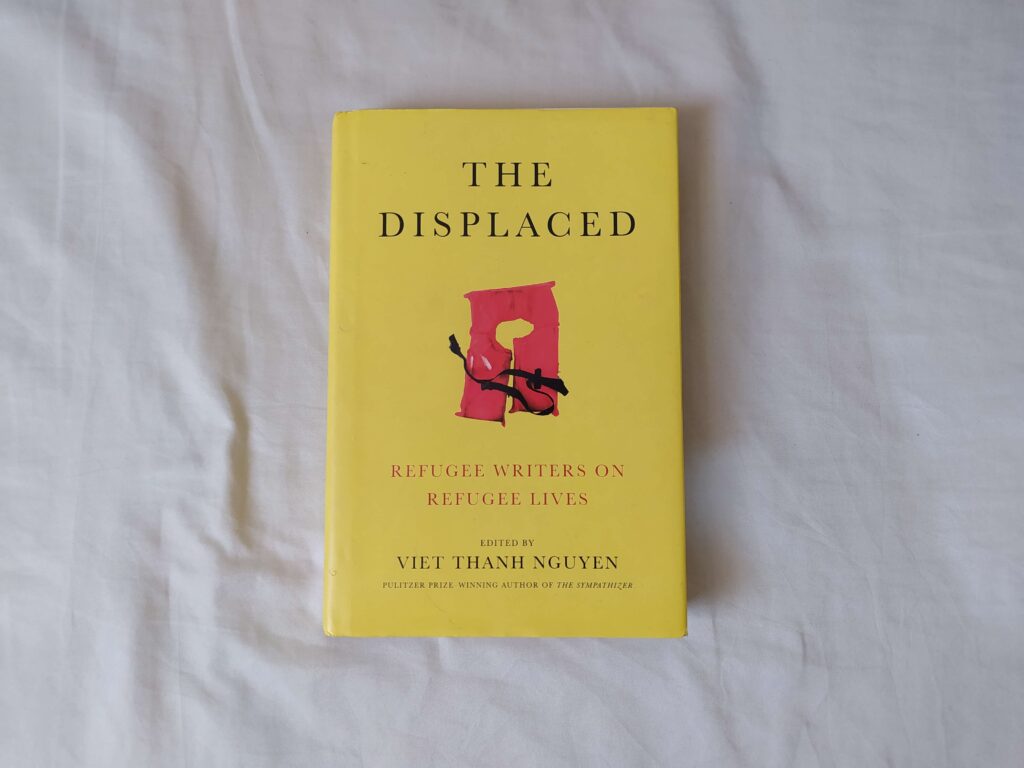In The Displaced: Refugee Writers on Refugee Lives (2018), Viet Thanh Nguyen writes in the introduction: “To become a refugee is to know, inevitably, that the past is not only marked by the passage of time, but by loss – the loss of loved ones, of countries, of identities, of selves.” The Displaced is a collection of non-fiction essays written by authors who have been displaced from their countries by war or extreme poverty and rendered refugees in foreign countries.
One of the many things I loved and appreciated about this book is how it brings into perspective the realness of what’s lost when one becomes a refugee. Reading the essays, I realized how certain aspects of human lives go unnoticeable, their importance unrecognized, until our circumstances force us to; until we’re face to face with these seemingly subtle things. One of the essays that paint this perspective in broader strokes is Joseph Azam’s Last, First, Middle.
Last, First, Middle by Joseph Azam
When was the last time you thought about your name? No, critically thought about it. What does it mean? How do you feel about it? What does it represent? How do others react to it? What has it (or not) done for you, and so on? Most of us don’t have to think about all this unless we are answering to our identity in settings such as the workplace, at home, or school. And even then, it’s often in a fleeting moment. For Azam and other refugees and immigrants, their names are a constant reminder of their foreignness.
Last, First, Middle is an essay by Joseph Azam based on his life as a refugee and immigrant in America, and how his given name (and what it represents at different points) has played a role in some of the decisions he and his immigrant parents have taken throughout his life. Azam is an Afghan-American lawyer and writer whose written work covers immigration policies, especially those affecting Afghanistan refugees. His legal and advocacy work includes serving as the Board Chair for the Afghan-American Foundation and on the National Welcome Council for Welcome.Us.
Summary
Azam’s father and mother had fled the war in Afghanistan before he was born. They had settled in Virginia in 1980 but went back in 1981 because of his grandfather’s deteriorating illness. Azam’s parents attempted to leave Afghanistan again when he was four months old but this time was not as easy as the first time. His father faced the risk of being forcefully enrolled to fight for the Russian-allied government. So his parents decided to leave Afghanistan separately and meet in Berlin later, where they would then travel to the United States together. After a few months and an unpleasant stop in India with his mother, the family finally reunites in Berlin and later, makes their way to New York City to seek asylum.
In New York, Azam’s parents immediately find menial jobs to do.They later open a rug and carpet shop, which later turns into a men’s shoe store. Their neighborhood is full of other immigrant families from different parts of the world, and although Azam does not understand what a refugee is when growing up, he remembers always feeling like an outsider. His name constantly reminds him of his foreignness throughout middle school and later in high school when his family moves to Orange County, California. He goes by different names in different stages of his life, which are all an attempt to fit in and make his life in the US as a foreigner easy. Finally given the agency to pick his legal name, Azam chooses a name that merges his Afghan ancestry and American identity.
In Azam’s Last, First, Middle, the name is not only a means of identity for refugees, but also a tie to their ancestral origin, as well as an indicator and reminder of their otherness when in foreign lands.
The Name as More Than Just an Identity in Last, First, Middle by Joseph Azam in The Displaced
Naming as a sacred process
Azam’s given name, Mohammad Yousuf Azam, is a big deal to him, his parents, and his grandfather. When Azam was born, his parents asked his grandfather (his baba jaan) to pick a name for him. His grandfather doesn’t take this task lightly and turns to one of the most important parts of his life — the Quran. He settled on the Surah Yousuf and thus the name Mohammad Yousuf Azam.
The Surah Yousuf, a narrative of the prophet Yousuf, teaches about courage, forgiveness, patience, and righteousness. By giving him this name, his grandfather speaks these values over Azam’s life. The name Mohammad is popular and holy among Muslims who carry it in the hope of following in Prophet Mohammad’s virtuous path. Azam is a family name that he shares with his grandfather, Haji Mohammad Azam. The full name is baba Jaan’s first present to Azam and he treasures it as weighty and meaningful. It’s his inheritance.
A refugee’s foreign name fuels the ever-constant feeling of otherness
However, Azam no longer feels this sense of pride about his name while growing up as a refugee in New York. The only identification he has is a green card with the words ‘Resident Alien’ at the top. His name, just like his form of identification, is now an indication of his foreignness, and this pours onto different areas of his life including school.
Unlike other students, Azam worries about his name at the beginning of every school year in the fall. “While some kids fretted about months of monotony, my angst was focused squarely on the first moments of the school year when roll would be taken out loud for the first time.” (29). He comes up with a routine to ensure all his new teachers don’t call out the name Mohammad and instead, use the name Yousuf. Azam’s given name, which previously felt like a part of his grandfather’s love for him, becomes a point of shame and embarrassment. Instead of the pride he once felt about his name and ancestry, Azam now feels like an outsider and his otherness is further cemented.
This is also the fate of other immigrant students and friends who go even further to abandon their foreign “strange sounding names” in the struggle to fit in. Azam doesn’t feel comfortable changing his name like his immigrant friends, but to his surprise, his father takes the matter into his own hands. A 2022 study shows that young refugees are more likely to have identity formation difficulties and mental health disorders due to the various stressors, traumatic events, and cultural changes they’re exposed to. Although Azam’s parents move to the US when he’s too young to understand this, he’s plagued by the feeling of being an outsider even before he knew what a refugee is.
When the family moves to California in 1996, Azam feels anxious about managing his feelings of otherness in a new environment. His parents recognize this unease and when he goes to enroll in a new school, his father registers him with an American name, Joseph Azam, instead. This further confirms the feeling of otherness that immigrants and refugees must live with, including his parents. They well understand the struggle of fitting in and Azam’s father’s actions are a clear indication. However, contrary to what Azam thought, changing his name from Yousuf to Joseph feels like a betrayal of his Afghan ancestry and a death of experiences that have shaped his life so far. At this point and age, Azam recognizes how his name carries his identity and all that he has been through.
“Being known as Joseph or Joe outside of my family brought with it the ordinaries and anonymity that I had so desperately wanted at age six, but at fifteen it brought me discomfort and waves of guilt at home.”
The name as a merger of different identities
In the end, when Azam gets the opportunity to choose his name, he finds himself face-to-face with the disharmony that has dominated his own name for years. Even with all his identification documents at hand, he still struggles to decide who he really is. Ultimately, Azam picks a name that reflects all that he is and has been, from a child in Afghanistan to an adult in America. “What I did next is simply what felt most honest. Instead of choosing between my names, I chose all of them.” (33)
Azam’s newly chosen name, Joseph Mohammad Yousuf Azam, is a conglomeration of his Afghan and American identities because he’s all of them. “… but it made whole again the hopes of my grandfather and added to them my own.”
Conclusion
A name is one part of our identity whose significance often goes unnoticed. But for Azam and other refugees, their names are an indicator of being an outsider, of their other otherness.
Joseph Azam’s essay Last, First, Middle in The Displaced is proof that refugees and immigrants don’t get to choose which of their experiences stay with them or shape their lives. Instead, they must find a way to integrate all these experiences, pleasant or unpleasant, into their lives. Trying to suppress or do away with some of the experiences causes an identity dissonance, similar to Azam’s dilemma of whether to be identifiably foreign or secretly false.



